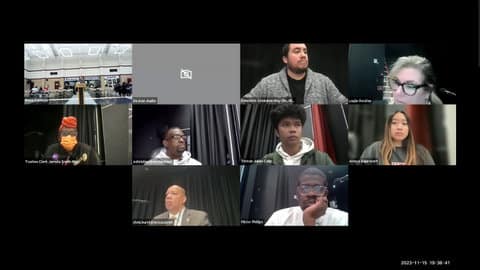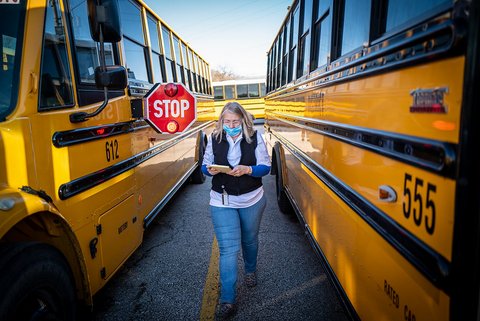
18 Nov Disadvantaged Students Are Especially Struggling Amid Teacher Shortages

Data and teacher perspectives indicate that students are struggling while the West Contra Costa Unified School District attempts to fill staff vacancies. (Screenshot captured by Samantha Kennedy / The CC Pulse)
By Samantha Kennedy
Teachers and administrators have warned the West Contra Costa school board of the impact of vacancies before — teacher burnout, poor retention and lack of student engagement and success. Student data provided at Wednesday’s meeting — despite showing some bright spots — and community member comments indicate that students continue to struggle while the district attempts to fill vacancies.
Trustee Leslie Reckler and clerk Jamela Smith-Folds wanted community members to understand that test scores are only one indicator of student success. Some test well; others may underperform. Research from the National Education Association has shown that standardized testing is not the most effective measurement of progress or growth.
>>>Read: Richmond Teacher Is ‘Very Happy’ UCs Dropped the SAT, ACT
But teachers who spoke at the meeting shared that students also struggle in everyday classroom instruction. Math and science teachers said their students’ success is especially affected by vacancies. Some older students, they said, are doing simple subtraction with calculators and are unaware of what the opposite operation of subtraction or addition is.
Students frequently underperform in other foundational skills, like reading, as well.
Data from iReady, an adaptive assessment system used by the district, shows that only about 12% of students tested in grades one to eight are at or above their grade’s reading level. About 20% of students are expected to be at or above grade level by the end of the year. And the rest, a bit over 75% of students tested, are one or more reading levels below their grade.
Black and Brown students are overrepresented in these below grade level scores. In October, only 13.8% of Black students and 12.36% of Hispanic and Latino students tested in those grades were at or above grade level or expected to be at the end of the year.
These inequities mirror general concerns teachers voiced about vacancies at Title I schools, which receive additional federal funding based on the number of low-income students. Many of those schools have high populations of Black and Brown students and have the highest amount of full-time employee vacancies.
According to numbers in an unrelated presentation by the United Teachers of Richmond, 48 out of the district’s 65 vacancies are in Title I schools.
English learners and students with disabilities are also overrepresented in low reading levels. Under 5% of English learners and 8.5% of students with disabilities are at their expected reading level or expected to be so at year’s end.
And while there is progress among some of these groups — about 10% of English learners are expected to be reclassified as fluent in English this school year, for example — other student populations reportedly struggle to get their most basic needs met.
Teachers and parents of students with disabilities said that services within some individual education plans are not being provided to students because of the vacancies. The board listened as one mother cried over Zoom because her son with autism was not receiving services from a speech therapist.
“My heart is always so heavy when I talk about him, knowing our son has to wait for help,” Sharzad Fernandez said, “when the need is now.”
Even when professionals are available to provide services, teacher vacancies cause students to be shuffled around, making them unable to be found, which leads to services not being provided.
Failure to provide services specified in an IEP that both the district and parent have agreed upon is illegal.
Another speaker during public comment, Sarah Creely, said that there has been no speech therapist at Hannah Ranch Elementary School in Hercules for 60 school days. Creely, who is a teacher at Hannah Ranch, said she has never seen something like this at a school district.
“In my 34 years of teaching, I have never seen such recklessness and disregarding student IEPs,” Creely said.
She and Fernandez both said they’ve reached out to district staff about the problem. That Wednesday morning, according to Creely, she sent an email to several staff members within the special education department and Smith-Folds, who represents the area of Hannah Ranch. Fernandez said her attempts at calling and emailing have been either ignored or responded to slowly, making her feel “passed along and pacified.”
But fixing these problems by filling vacancies will not be easy, financially speaking. Board President Demetrio Gonzalez-Hoy, who sits alongside Smith-Folds on the Budget/Contract Committee, said the lack of savings is concerning to him.
“I’m praying something comes out in January that shows a better picture,” Gonzalez-Hoy said, speaking about potentially receiving funding from sources like the state. He said the budget committee expected to find $5 million in savings but has only found $2 million and is nearly finished looking.
Trustee Mister Phillips said it’s essential to be transparent with the community as bargaining begins with UTR, the teachers’ union.
The next WCCUSD school board meeting is Dec. 6.






No Comments